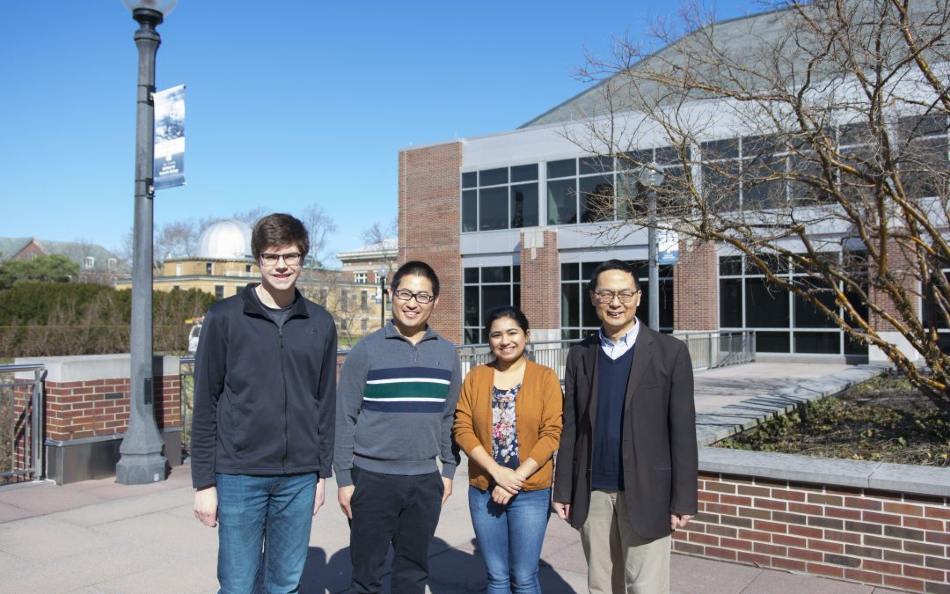Mar 30 2020
Scientists have created a set of three novel tools to design Issatchenkia orientalis, a low-pH-tolerant yeast, for synthesizing valuable bioproducts from renewable biomass.
 University of Illinois Department of Chemical and Biomolecular Engineering scientists (from left) William L. Lyon, Mingfeng Cao, Zia Fatma, and Huimin Zhao. Image Credit: University of Illinois at Urbana-Champaign.
University of Illinois Department of Chemical and Biomolecular Engineering scientists (from left) William L. Lyon, Mingfeng Cao, Zia Fatma, and Huimin Zhao. Image Credit: University of Illinois at Urbana-Champaign.
The study has been described in a paper published in the Metabolic Engineering journal, summarizing the three-pronged method as well as its significance to the field of sustainable chemical production.
The researchers worked under the guidance of Mingfeng Cao, a Research Scientist at the Department of Chemical and Biomolecular Engineering (ChBE) of the University of Illinois at Urbana-Champaign.
Cao works in ChBE Professor Huimin Zhao’s (MMG/BSD leader/CABBI) laboratory at the Center for Advanced Bioenergy and Bioproducts Innovation (CABBI), a Bioenergy Research Center (BRC) funded by the U.S. Department of Energy. CABBI Postdoctoral Researcher Zia Fatma is a co-author of the study, who also works in Zhao’s laboratory.
While attempting to reduce the dependence on non-renewable fossil fuels, researchers are finding out techniques to generate valuable products from renewable biomass by employing organisms like yeast.
Metabolic engineering—the process of editing the genetic blueprint of cells to generate higher quantities of preferred substances—is vital to produce economically competitive amounts of such products.
Earlier, researchers designed the traditional yeast Saccharomyces cerevisiae in this way. S. cerevisiae is a production host that is commonly used due to its conduciveness to genetic manipulation, making it a primary candidate for metabolic engineering.
In addition to conventional yeasts, we’re discovering that nonconventional yeasts can prove to be just as high-performing. The more organisms we can engineer for valuable compound production, the more opportunities we will have in order to make chemical production economically and environmentally sustainable.
Mingfeng Cao, Research Scientist, Department of Chemical and Biomolecular Engineering, University of Illinois at Urbana-Champaign
The focus of the study by Cao and Zhao is on the yeast strain I. orientalis, which is well known for its capacity to grow in low-pH environments. Researchers consider that due to such a resistance for extreme acidity, I. orientalis is regarded as a powerful organic acid producer.
To date, the practicability of using I. orientalis to produce chemicals has not been explored much since there has been a shortage of genetic manipulation approaches. The researchers of CABBI rectified this knowledge gap by creating three main tools.
Earlier, the research group had found a genetic tool including plasmids, which are DNA molecules vital for genetic manipulation and reproduction. Plasmids must be in a position to replicate in a stable way to modify the genome of an organism.
The researchers demonstrated that it is possible to use an independently replicating DNA sequence (ARS) from S. cerevisiae to stabilize plasmid replication in I. orientalis. However, this is feasible only to a certain level, and the addition is inadequate, on its own.
The ARS should be augmented with a functional centromere (CEN)—the portion of a DNA sequence that stabilizes the division of cells—to realize stability and to make I. orientalis responsive to CRISPR/CAS9 gene editing systems.
The first innovative genetic tool found in this research is a functional CEN sequence in the I. orientalis genome. A CEN-ARS pairing is crucial for the stable division of plasmids, thus this finding enables genetic engineering of I. orientalis to achieve for high-value and high-quantity production of compounds.
Apart from isolating a CEN sequence in I. orientalis, the researchers determined the constitutive promoters and terminators—components in a DNA strand that impact the expression of genes).
To enhance an organism for chemical production, it is essential to finely adjust its genetic expression, which is the direct result of the behavior of promoters and terminators. Researchers can characterize robust promoters and terminators in I. orientalis to be able to design the specific expressions essential to generate chemicals at high levels.
The third innovative tool developed by the CABBI scientists is a fast and efficient in vivo (implies “within a living organism”) DNA assembly technique that involves building a biochemical pathway in I. orientalis.
It is crucial to typically engineer cellular pathways—chains of reactions and actions that take place inside a cell and lead to a preferred product or response—for processes in I. orientalis to become economically viable and high-yielding.
The researchers took a xylose utilization pathway developed originally for S. cerevisiae as an example and employed an in vivo DNA assembly technique to develop a similar synthetic pathway in I. orientalis. Consequently, I. orientalis could use xylose as a sole carbon source.
This example was not completely optimized but showed that it is possible to use a more advanced in vivo assembly technique for efficient engineering of reliable biosynthetic pathways within I. orientalis, eventually leading to valuable compound production.
In summary, this study produced a strong set of three innovative genetic tools to enable increased expression of target genes and help manufacture bioproducts like organic acids from the yeast I. orientalis.
Apart from Cao, Zhao, and Fatma, the research group included CABBI’s Yasuo Yoshikuni and Ping-Hung Hsieh, Lawrence Berkeley National Laboratory; CABBI’s Vinh G. Tran, ChBE at Illinois; William L. Lyon, ChBE; Xiaofei Song, Department of Microbiology, Nankai University, Tianjin, China; Maryam Sayadi, Genome Informatics Facility, Office of Biotechnology, Iowa State University; and Zengyi Shao, Department of Chemical and Biological Engineering, Iowa State University.